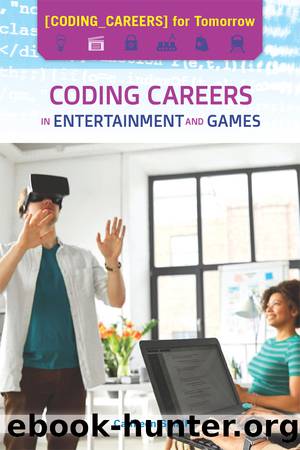Coding Careers in Entertainment and Games by Small Cathleen;

Author:Small, Cathleen;
Language: eng
Format: epub
Publisher: Cavendish Square Publishing LLC
Published: 2019-06-04T00:00:00+00:00
This glove is designed to read and record movement for a virtual reality experience.
An example of large-scale virtual reality is the Toy Story Midway Mania attraction at several of the Disney theme parks. Riders of Midway Mania wear 3D glasses and ride vehicles that go through a number of 3D virtual worlds, playing carnival games along the way. As the riders go through the ride, they play shooting games, throwing games, and a ring-toss game, earning points as they go. Itâs both game and theme-park ride all in one.
This is all accomplished by a control system that has three components: for the games, for the special effects, and for the ride itself. All three components have software that must work seamlessly for a realistic VR experience. Behind the creation of all that software was a very large team of coders.
Pokémon GO is a great example of augmented reality in action. The game, run on mobile devices, takes the actual environment a person is in and overlays Pokémon creatures onto it. The game runs on the Unity 3D engine, so C# programming wouldâve been a requirement for the game development team.
The Unity 3D engine is used for a lot of VR/AR applications, but the Unreal engine is widely used as well. C++ is supported by Unreal, so in the case of VR/AR development, it would be wise to know the two languages used by the Unity 3D and Unreal game engines: C# and C++.
For any sort of development for VR or AR, many programming languages can work, but the important thing is to find one in which the code is fastâit needs to support a high, consistent frame rate.
Back in the earlier days of gaming and animation, characters and effects sometimes took a while to renderâ you had to wait for the entire graphic to load and to then animate in the way it was intended. Slow rendering will destroy the ârealityâ of an AR or VR experience, which is why itâs most important to code in a language that will deliver fast performance.
The C languages (C, C#, and C++) are popular for VR and AR programming, and so are Java, JavaScript, and Python.
FACIAL AND VOICE RECOGNITION
Handheld controllers can do a lot, but new technology has allowed people to use voice commands in games, and that technology has expanded beyond gaming too. Devices like the Amazon Echo and Google Home respond with great accuracy to voice commands, allowing users to perform many tasks without so much as picking up their smartphone or laptop.
Facial recognition doesnât let users necessarily control their gamesâyet. However, new technologies may allow games to adjust based on the emotions reflected in a gamerâs face. Additionally, facial recognition technology allows people to create avatars to use in gaming, social media, and more.
RealSense
Intel has long made microprocessors, chips, and circuits, but they are also the pioneers behind the RealSense technology. RealSense allows cameras and related devices to âseeâ and process depth perception. A traditional camera, no matter how powerful, sees and displays the world in two dimensions.
Download
This site does not store any files on its server. We only index and link to content provided by other sites. Please contact the content providers to delete copyright contents if any and email us, we'll remove relevant links or contents immediately.
The Basics of Organic Chemistry by Clowes Martin;(331)
The Science of Philip Pullman's His Dark Materials by Mary Gribbin(326)
Fake News and Propaganda by Fiona Young-Brown(323)
Harry Potter and the Sorcerer's Stone: SparkNotes Literature Guide by SparkNotes(291)
Flowers in the Gutter by K. R. Gaddy(256)
Braiding Sweetgrass for Young Adults by Robin Wall Kimmerer(250)
Super Simple Chemistry by D.K. Publishing(248)
Exam Success in Geography for IGCSE & O Level by Unknown(246)
Summary of the Selfish Gene by Readtrepreneur Publishing(245)
JavaScript Coding for Teens: A Beginner's Guide to Developing Websites and Games by Yueh Andrew(235)
Dark days in Salem: the witchcraft trials by Deborah Kent(230)
The Python Audio Cookbook;Recipes for Audio Scripting with Python by Alexandros Drymonitis(230)
Analysis and Linear Algebra for Finance: Part II by Bookboon.com(222)
Key Immigration Laws by Kathryn Ohnaka(219)
Cracking the AP Economics Macro & Micro Exams, 2017 Edition by Princeton Review(209)
The Science of Fashion by Julie Danneberg;(201)
Solutions for a Cleaner, Greener Planet: Environmental Chemistry by Marc Zimmer(198)
Reverse Engineering For Everyone! by mytechnotalent(192)
The Basics of Biochemistry by Kyle Kirkland(186)
